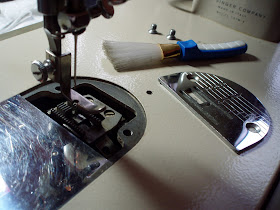I pulled out my sewing machine manual the other day to read up on its zipper foot and stumbled upon a few pages dedicated to maintenance. Apparently, you're supposed to remove lint and oil the machine on a regular basis, which certainly hasn't been happening since I came into possession of this machine. However, since I've decided to sew more often, I think it's time to learn this important process.
To clean and oil a sewing machine, you need the following items:
- The manual; this very important guide outlines the steps to clean and oil your particular machine
- A lint brush
- A Swiffer cloth if you haven't removed dust and lint in a while
- Sewing machine oil
- Sewing machine lubricant
- Screwdrivers
- Anything else outlined by your manual
The first step in machine maintenance is removing dust and lint, both on the surface and behind different plates. Your manual will tell you which plates to remove for dusting. I used my Swiffer cloth to get rid of the big dust bunnies and the lint brush to eliminate dust in small, delicate spaces. This type of maintenance should be done every week.
After dusting, it's onto routine oiling. For me, this consists of putting a drop of oil in the bobbin housing (above) and in several places on the top of the machine (below); the exact locations are detailed in the manual. Like dusting, oiling my machine needs to be done on a weekly basis.
My machine also requires oil and lubricant on a monthly basis in entirely different locations. Be careful not to mix oil and lubricant, as different parts of the machine should not be oiled. This process required me to tip everything over to expose and oil the underside of the machine (below), which was pretty cool.
The final step of maintenance is running some scrap fabric through the machine in case any oil leaks onto the stitching area. Overall, the dusting, oiling, and lubricating process took me just over 30 minutes; it should go faster in the future, now that I am familiar with the layout in my machine. I can already tell that my machine is running better and I hope that with regular care, my 40-year-old machine will run for another 40 years.






yep, very important to take care of your machine (says the girl who doesn't do so on a regular basis thus explaining the recent $100 trip to the sewing machine repair center!)
ReplyDeleteOooooh, I should be doing this, shouldn't I... Thanks for the tutorial! I'll have to look for my sewing machine manual now...
ReplyDelete